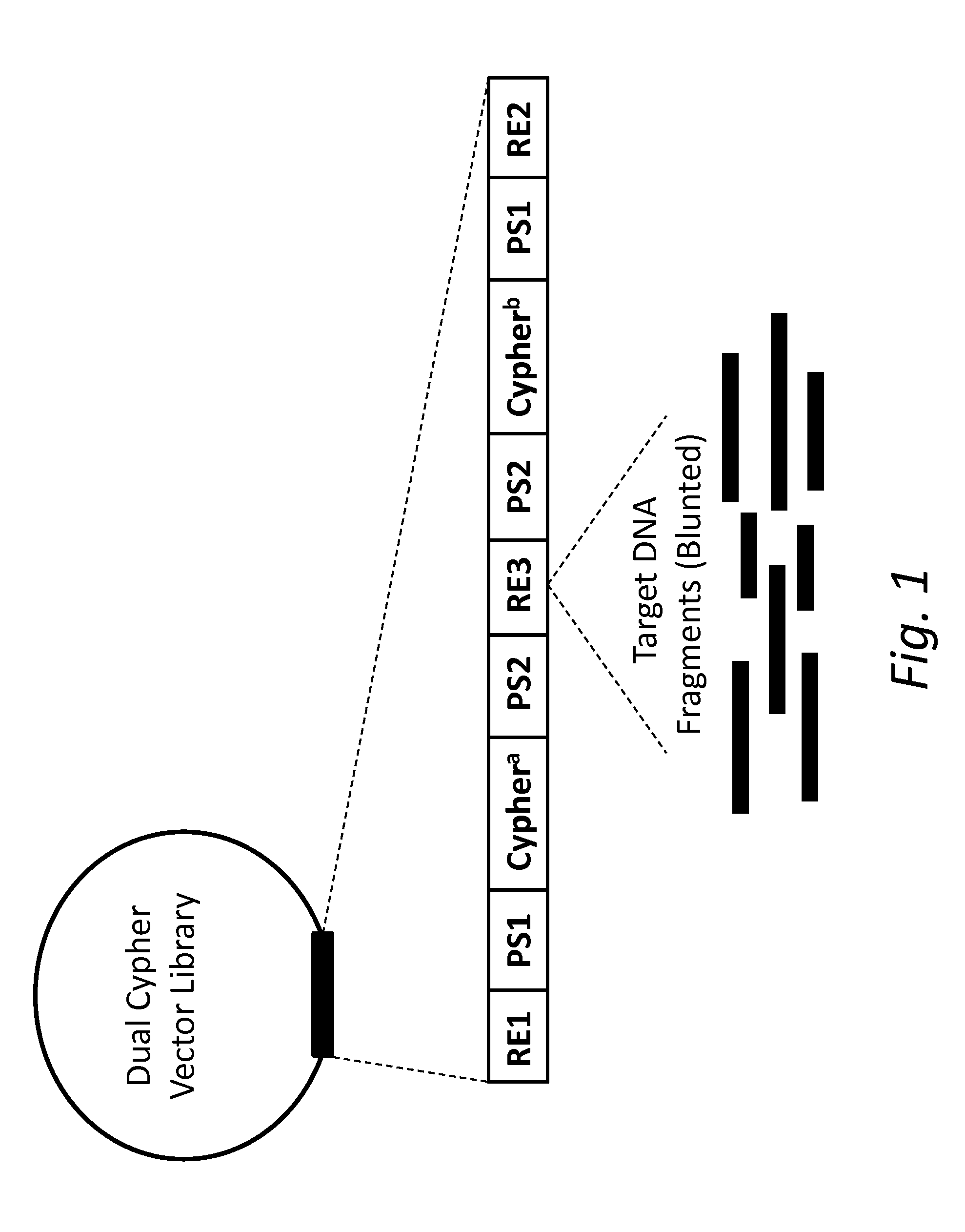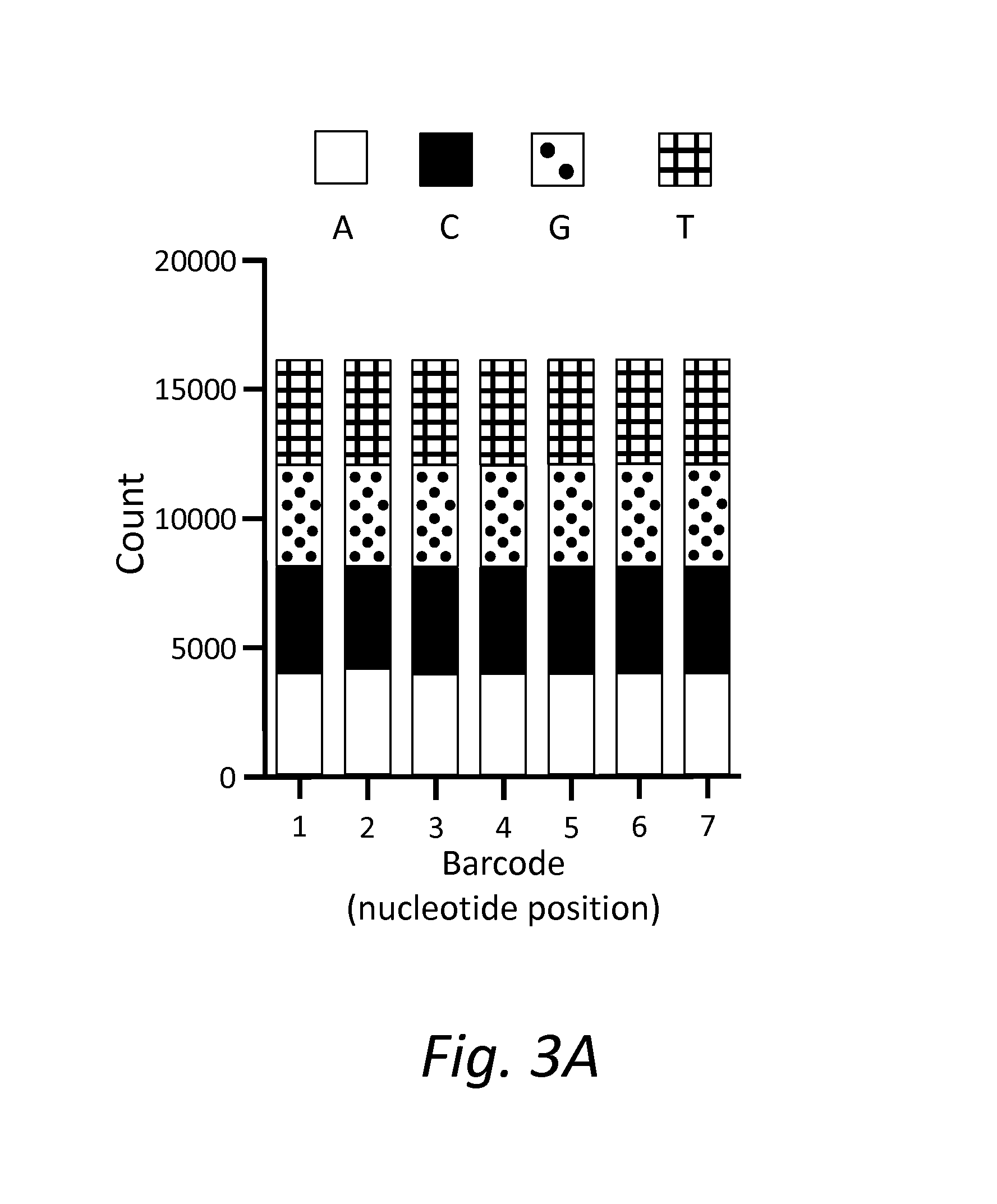Compositions and methods for accurately identifying mutations
a technology applied in the field of composition and detection method of accurately detecting mutations using sequencing, can solve the problems of insufficient sensitiveness of available sequencing methods to detect rare mutations, inherent error rate, and difficulty in detecting spontaneous mutations (e.g., substitution, insertion, deletion, etc., to achieve the effect of detecting rare mutations and detecting spontaneous mutations
- Summary
- Abstract
- Description
- Claims
- Application Information
AI Technical Summary
Benefits of technology
Problems solved by technology
Method used
Image
Examples
example 1
Dual Cypher Sequencing of a Tumor Genomic Library
[0065]Cancer cells contain numerous clonal mutations, i.e., mutations that are present in most or all malignant cells of a tumor and have presumably been selected because they confer a proliferative advantage. An important question is whether cancer cells also contain a large number of random mutations, i.e., randomly distributed unselected mutations that occur in only one or a few cells of a tumor. Such random mutations could contribute to the morphologic and functional heterogeneity of cancers and include mutations that confer resistance to therapy. The instant disclosure provides compositions and methods for distinguishing clonal mutations from random mutations.
[0066]To examine whether malignant cells exhibit a mutator phenotype resulting in the generation of random mutations throughout the genome, dual cypher sequencing of present disclosure will be performed on normal and tumor genomic libraries. Briefly, genomic DNA from patient...
example 2
Dual Cypher Sequencing of a mtDNA Library
[0069]Mutations in mitochondrial DNA (mtDNA) lead to a diverse collection of diseases that are challenging to diagnose and treat. Each human cell has hundreds to thousands of mitochondrial genomes and disease-associated mtDNA mutations are homoplasmic in nature, i.e., the identical mutation is present in a preponderance of mitochondria within a tissue (Taylor and Turnbull, Nat. Rev. Genet. 6:389, 2005; Chatterjee et al., Oncogene 25:4663, 2006). Although the precise mechanisms of mtDNA mutation accumulation in disease pathogenesis remain elusive, multiple homoplasmic mutations have been documented in colorectal, breast, cervical, ovarian, prostate, liver, and lung cancers (Copeland et al., Cancer Invest. 20:557, 2002; Brandon et al., Oncogene 25:4647, 2006). Hence, the mitochondrial genome provides excellent potential as a specific biomarker of disease, which may allow for improved treatment outcomes and increased overall survival.
[0070]Dual ...
example 3
High-Resolution Detection of TP53 Mutations
[0072]A recent genomics study determined that TP53 is mutated in 96% of high grade serous ovarian carcinoma (HGSC), responsible for two-thirds of all ovarian cancer deaths (Cancer Genome Atlas Research Network, Nature 474:609, 2011), and current models indicate that TP53 loss is an early event in HGSC pathogenesis (Bowtell, Nat. Rev. Cancer 10:803, 2010). Thus, the near universality and early occurrence of TP53 mutations in HGSC make TP53 a promising biomarker candidate for early detection and disease monitoring of HGSC. Dual cypher sequencing of present disclosure was used to detect somatic TP53 mutations that arose during replication in E. coli.
Dual Cypher Vector Construction
[0073]An oligonucleotide containing EcoRI and BamHI restriction enzyme sites, adapter sequences, indices, and random 7-nucleotide barcodes flanking a SmaI restriction enzyme site with the following sequence was made (Integrated DNA Technologies): GATACAGGATCCAATGATAC...
PUM
| Property | Measurement | Unit |
|---|---|---|
| length | aaaaa | aaaaa |
| somatic mutation frequency | aaaaa | aaaaa |
| mutation frequencies | aaaaa | aaaaa |
Abstract
Description
Claims
Application Information
 Login to View More
Login to View More - R&D
- Intellectual Property
- Life Sciences
- Materials
- Tech Scout
- Unparalleled Data Quality
- Higher Quality Content
- 60% Fewer Hallucinations
Browse by: Latest US Patents, China's latest patents, Technical Efficacy Thesaurus, Application Domain, Technology Topic, Popular Technical Reports.
© 2025 PatSnap. All rights reserved.Legal|Privacy policy|Modern Slavery Act Transparency Statement|Sitemap|About US| Contact US: help@patsnap.com



